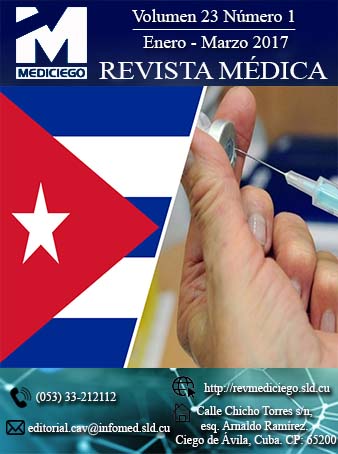Family and knowledge about child abuse
Abstract
Introduction: as an expression of violence, child abuse is a major health problem; this phenomenon has particular characteristics and serious consequences for the health of the child. The family, as the first socializing space, transmits norms and values charged with reiterative force and affective significance for its members, with the particularity that the manifestations of violence are closely linked to their intergenerational history.
Objective: to determine the level of knowledge about child maltreatment in families of the Popular Council "Pedro Martínez Brito" in Ciego de Ávila.
Method: a cross-sectional descriptive study was carried out in families belonging to six medical clinics in the area. From a universe of 1 150 families with infants, a sample of 407 families with children aged 0-10 years was selected. The information was obtained from the individual medical records and family files of the clinics; a validated questionnaire was used to survey the families.
Results: most of the children (60,8 %) lived only with their mothers –single or divorced– and 32,9 % with both parents. Families were classified as severely dysfunctional (4,4 %), dysfunctional (36,1 %), moderately functional (34,1 %) and functional (25,3 %). Only 46,8 % of the families showed knowledge about child maltreatment; the majority expressed attitudes and practices that evidenced ignorance on the subject.
Conclusions: the traditional conception of the family as a private reality makes it difficult for its members to identify and correct norms and behaviors that generate child maltreatment and to acquire knowledge about itDownloads
Published
How to Cite
Issue
Section
License
Copyright (c) 2021 Grisel María Alonso Gutiérrez, Rafael González Caballero, Cristóbal Martínez Gómez, Belkis María Ruiz Rodríguez, Sergio Adolfo Marrero Halles, Yaney Zayas Ribalta

This work is licensed under a Creative Commons Attribution 4.0 International License.
Those authors who have publications with this journal accept the following terms of the License CC Attribution-NonCommercial 4.0 International (CC BY-NC 4.0):
You are free to:
- Share — copy and redistribute the material in any medium or format for any purpose, even commercially.
- Adapt — remix, transform, and build upon the material for any purpose, even commercially.
The licensor cannot revoke these freedoms as long as you follow the license terms.
Under the following terms:
- Attribution — You must give appropriate credit , provide a link to the license, and indicate if changes were made . You may do so in any reasonable manner, but not in any way that suggests the licensor endorses you or your use
- No additional restrictions — You may not apply legal terms or technological measures that legally restrict others from doing anything the license permits.
The journal is not responsible for the opinions and concepts expressed in the works, which are the exclusive responsibility of the authors. The Editor, with the assistance of the Editorial Committee, reserves the right to suggest or request advisable or necessary modifications. Original scientific works are accepted for publication, as are the results of research of interest that have not been published or sent to another journal for the same purpose.
The mention of trademarks of specific equipment, instruments or materials is for identification purposes, and there is no promotional commitment in relation to them, neither by the authors nor by the editor.






















